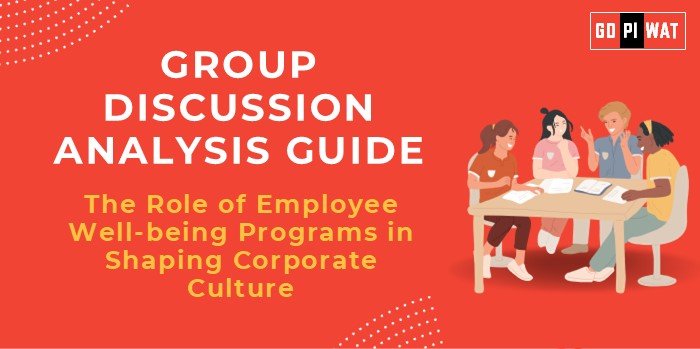📋 Group Discussion (GD) Analysis Guide
🌟 The Role of Employee Well-being Programs in Shaping Corporate Culture
🌐 Introduction to the Topic
- Opening Context: “In today’s dynamic work environment, employee well-being programs are no longer a ‘nice-to-have’ but a strategic imperative. A company’s culture often reflects how it values its workforce, and robust well-being initiatives play a pivotal role in boosting morale, productivity, and retention.”
- Topic Background: Originating in the early 20th century with industrial welfare initiatives, employee well-being has evolved into holistic programs addressing physical, mental, financial, and social health. Companies today leverage these programs to foster positive corporate cultures amid rising burnout, workplace stress, and hybrid work challenges.
📊 Quick Facts and Key Statistics
- 🌍 Global Wellness Market: Valued at $4.5 trillion, showcasing the scale of well-being investment.
- 📉 Burnout Impact: 76% of employees globally report workplace stress, per Gallup 2023.
- 📈 Productivity Gains: Companies with strong well-being programs see a 23% increase in productivity (Harvard Business Review).
- 🤝 Engagement Link: 70% of employees say well-being programs improve engagement and loyalty (Deloitte, 2023).
- 🔒 Attrition Prevention: Organizations investing in wellness report 35% lower attrition rates.
👥 Stakeholders and Their Roles
- Organizations: Develop and implement well-being initiatives tailored to employee needs.
- HR Departments: Act as facilitators, integrating programs with performance and culture goals.
- Employees: Active participants who benefit from improved physical and mental health.
- Leadership: Champions of well-being programs that align organizational goals with employee satisfaction.
- Governments and NGOs: Encourage workplace wellness through regulations, guidelines, and partnerships.
🏆 Achievements and Challenges
🌟 Achievements
- Increased Employee Productivity: Google’s “gPause Program” reduced employee stress by 40%, leading to improved output.
- Lower Healthcare Costs: Johnson & Johnson’s wellness programs saved $250 million in healthcare expenses over a decade.
- Enhanced Employee Engagement: Microsoft’s “Well-being Week” promotes work-life balance, enhancing job satisfaction.
- Retention Gains: Companies like Salesforce achieve lower turnover due to employee-centered cultures.
⚠️ Challenges
- Implementation Gaps: Small and mid-sized firms often lack resources to roll out holistic well-being programs.
- Cultural Resistance: Traditional mindsets may see well-being initiatives as non-essential.
- Measuring ROI: Companies struggle to quantify the direct impact of well-being programs on bottom lines.
🌍 Global Comparisons
- Denmark: A global leader in employee happiness with mandatory wellness leave and flexible working models.
- Japan: Struggles with a work-centric culture but improving through mandatory stress management programs.
🗣️ Structured Arguments for Discussion
- Supporting Stance: “Employee well-being programs foster loyalty, reduce absenteeism, and enhance productivity, making them indispensable for a healthy corporate culture.”
- Opposing Stance: “Companies may waste resources on programs that lack measurable ROI, diverting focus from core business functions.”
- Balanced Perspective: “While implementing well-being programs incurs initial costs, their long-term impact on employee satisfaction, retention, and productivity outweighs the challenges.”
🎯 Effective Discussion Approaches
🌟 Opening Approaches
- Data-Driven Start: “76% of employees worldwide cite workplace stress, and organizations investing in wellness report 35% lower attrition rates…”
- Case Study Start: “At Google, the implementation of mindfulness programs reduced stress levels by 40%, leading to measurable productivity improvements.”
⚡ Counter-Argument Handling
Challenge ROI Concerns: “While ROI can be challenging to measure, data from companies like J&J show a direct reduction in healthcare costs due to wellness initiatives.”
Address Resistance: “Initial resistance can be addressed by integrating well-being programs into daily workflows rather than treating them as ‘add-ons.’”
🔍 Strategic Analysis of Strengths and Weaknesses
- Strengths: Improved morale, productivity, and retention; positive corporate branding and enhanced talent acquisition.
- Weaknesses: High costs for implementation and scalability; measuring ROI remains difficult.
- Opportunities: Use of AI and data analytics to personalize wellness programs; integration with hybrid work policies for better flexibility.
- Threats: Risk of tokenism without sustained leadership commitment; burnout persists if programs are poorly designed or underutilized.
🎓 Connecting with B-School Applications
📚 Real-World Applications
- Operations: Linking well-being programs with workflow efficiency strategies.
- Finance: Budget allocation for wellness initiatives to reduce long-term costs.
- HR: Designing inclusive programs for diverse, global workforces.
❓ Sample Interview Questions
- “How do employee well-being programs contribute to organizational performance?”
- “Evaluate the challenges organizations face in measuring the success of wellness initiatives.”
💡 Insights for B-School Students
- Linking employee satisfaction to long-term financial performance.
- Designing well-being frameworks as future leaders.
- Promoting mental health awareness in leadership roles.


